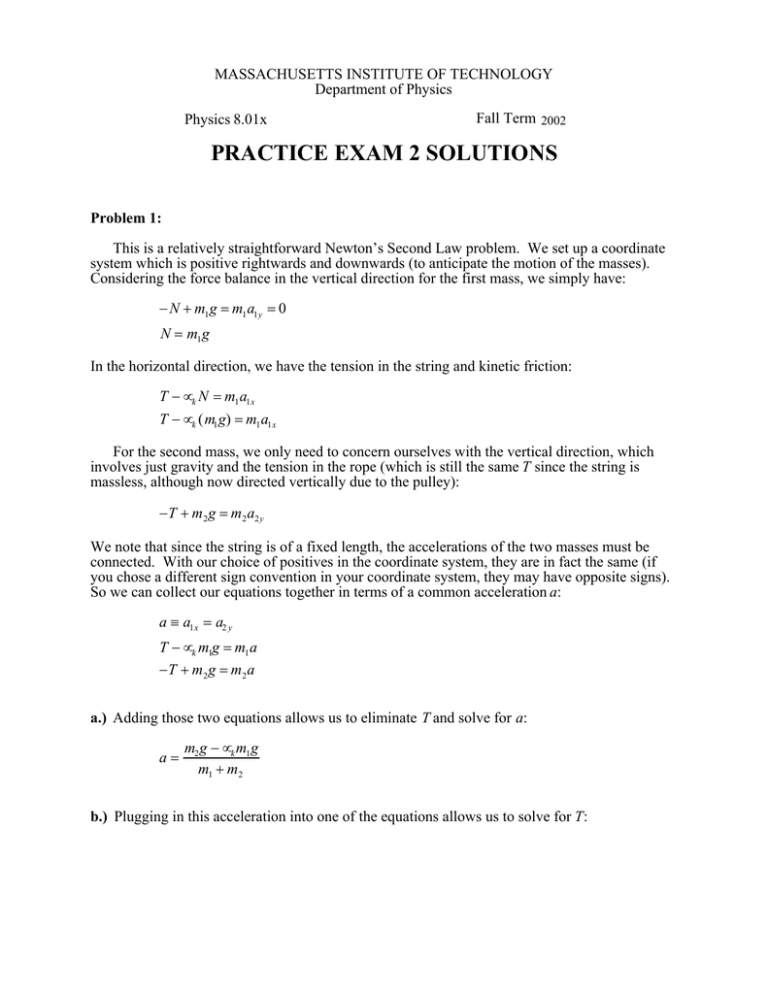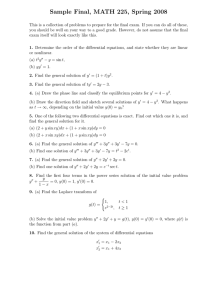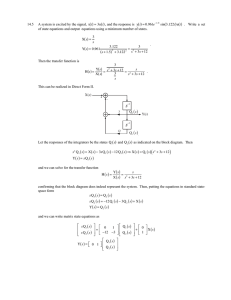PRACTICE EXAM 2 SOLUTIONS
advertisement

MASSACHUSETTS INSTITUTE OF TECHNOLOGY Department of Physics Physics 8.01x Fall Term 2002 PRACTICE EXAM 2 SOLUTIONS Problem 1: This is a relatively straightforward Newton’s Second Law problem. We set up a coordinate system which is positive rightwards and downwards (to anticipate the motion of the masses). Considering the force balance in the vertical direction for the first mass, we simply have: − N + m1 g = m1 a1y = 0 N = m1 g In the horizontal direction, we have the tension in the string and kinetic friction: T − µk N = m1 a1x T − µk (m1 g) = m1 a1x For the second mass, we only need to concern ourselves with the vertical direction, which involves just gravity and the tension in the rope (which is still the same T since the string is massless, although now directed vertically due to the pulley): −T + m2 g = m2 a2y We note that since the string is of a fixed length, the accelerations of the two masses must be connected. With our choice of positives in the coordinate system, they are in fact the same (if you chose a different sign convention in your coordinate system, they may have opposite signs). So we can collect our equations together in terms of a common acceleration a: a ≡ a1x = a2 y T − µk m1g = m1 a −T + m2 g = m2 a a.) Adding those two equations allows us to eliminate T and solve for a: a = m2 g − µk m1 g m1 + m2 b.) Plugging in this acceleration into one of the equations allows us to solve for T: T = m2 g − m2 a ⎛ m g − µk m1 g⎞ ⎟ T = m2 g − m2 ⎜ 2 ⎝ m1 + m2 ⎠ T = m1 m2 g (1+ µ k ) m1 + m2 c.) We know the acceleration and the distance b, so this part is just a simple application of kinematics: 1 2 at 2 2b t= = a x= 2b(m1 + m2 ) m2 g − µk m1 g d.) Once we know the time and the acceleration, the velocity is easily obtained by just plugging in our previously obtained values: v = at v = 2b (m2 g − µk m1 g) m1 + m2 Problem 2: a.) A free-body force diagram for the mass shows the two forces acting on it: gravity downwards, and the normal force perpendicular to the surface of the cone. Note that you should not draw an additional “centripetal force” on your diagram: this is just a label which we apply to forces which are directed radially inward: in this case the normal force’s horizontal component. N α α mg b.) We can find the speed of the mass by using the fact that it is moving in a constant horizontal circle. Set up a coordinate system with positive upwards and radially outwards, and consider the force equations in the two directions: ∑F = may ∑F = max y N sinα − mg = 0 x ⎛ −v 2 ⎞ − N cosα = m⎜ ⎝ r ⎠ Now by dividing our two equations (after rearranging the mg onto the other side in the first one), we can eliminate N and solve for the velocity: N cosα mv 2 = N sin α rmg rg v2 = tan α v = rg cot α c.) In one circle, the mass will travel a distance equal to the circumference, 2πr. So, since we know the velocity, we can find the time of a complete circle easily: T= 2πr r r tanα = 2π = 2π v g cot α g d.) It was a little unclear in the original problem setup whether the mass was sliding around in a circle on a fixed frictionless surface, or stationary on a rotating frictionless surface. For this part of the problem, this distinction is important: the mass is stationary on the inner surface of the cone that is rotating, so we can have static friction between the mass and the surface. N µN α α mg At the maximum speed before slipping, the static friction force will be directed downward along the surface of the cone to keep the mass from sliding upwards and outwards. We can add it to our force balance equations and re-solve for the velocity. The trickiest part is getting the angle and the sign of the frictional force correct: ∑F y = may N sinα − µs N cosα − mg = 0 ∑F x = max ⎛ −v 2 ⎞ − N cosα − µs N sin α = m⎜ ⎝ r ⎠ As before, we can move mg to the other side and divide the two equations to cancel N and solve for the velocity: N cosα + µs N sin α mv2 = N sinα − µs N cos α rmg v = rg cosα + µs sin α sin α − µs cos α Problem 3: For this problem, we will have to use all of the conditions of static equilibrium: that the forces are balanced in all directions, and that the total torque is zero for any choice of pivot point. a.) Since the force F is completely unknown, it makes sense to place our pivot point at that location, to eliminate it from our torque equation. Since this is also along the line of action of the gravitational weight of the foot (at its center of mass), we eliminate two forces for the price of one. As usual we will adopt a coordinate system which is positive rightwards and upwards, and with the positive sense of rotation being counterclockwise for computing cross products. The torque about our chosen pivot is: ∑τ = 0 −(T sinα ) d + Nb = 0 We note that the normal force is equal to half the weight of the person, since the problem states the weight is evenly distributed on both feet. Plugging that in for N, we can solve for T: T= mgb 2d sinα b.) To get a handle on the force F and its angle, we now need to consider force balance in the x and y directions. Do not neglect the weight of the foot, even though that force is not indicated in the diagram provided in the problem. ∑F x =0 T cosα − F sin β = 0 ∑F y = 0 T sinα − F cos β + N − mf g = 0 By rearranging terms and dividing the two equations to eliminate F, we can solve for the unknown angle: sin β T cosα = cos β T sin α + N − m f g mgb cosα tan β = mgb2d sinα mg sinα + − mf g 2d sin α 2 ⎛ ⎞ mb cotα ⎟ β = arctan⎜ ⎝ mb + md − 2m f d ⎠ c.) We can plug this back into one of our force equations to find the magnitude of the force: T cosα − F sin β = 0 T cosα F= sinβ Actually plugging in the torque and angle don’t do much for the algebra, so we can just leave our answer in this form, as all the quantities are known from previous parts of the problem. Problem 4A: a.) Considering the force balance on the pennies, we have their gravitational weight balanced by the spring force of the rubber band. Taking upwards to be positive: − mp g + k(l − l0 ) = 0 k = mp g l − l0 b.) For the purposes of this problem, we can neglect the mass of the rubber band and the effects of gravity. In this case, we have only the spring force of the rubber band providing the centripetal force for the circling nut. Taking radially outwards to be positive: F = mn a − k(d − l0 ) = mn (−4π 2 rf 2 ) Now we can plug in our previous expression for k and solve for the frequency f: ⎛ m g ⎞ ⎛ d − l0 ⎞ ⎟ f2 = ⎜ p ⎟⎜ ⎝ l − l0 ⎠ ⎝ mn 4π 2 r ⎠ ⎛ m g ⎞ ⎛ d − l0 ⎞ ⎟ f = ⎜ 2p ⎟ ⎜ ⎝ 4π mn r ⎠ ⎝ l − l0 ⎠ c.) The frequency is the number of cycles per second, so the period (the number of seconds per cycle) is just the inverse of it: T= 1 f d.) The angular frequency is the number of radians per second. Since there are 2π radians per complete cycle, the angular frequency is just: ω = 2πf For simplicity, we can leave our answers in this form instead of substituting in an explicit expression for f, which is already solved for. Problem 4B: Starting from our assumed power-law force equation, we can take the log of both sides to isolate the power-law exponent: Fm = a( Sc )b log Fm = loga + b(log Sc ) We see that under the log transform, the data should follow a straight line with slope b and intercept log a. Examining the data, the straight line fit passes approximately through the first and the last data point, so we can extract the slope from those two: log y2 − log y1 log x2 − log x1 log0.055 − log 0.34 b= = −2.0 log 25 − log10 b= Note that the particular units of the measurements do not matter, since a difference of logs is simply the log of the ratio of the quantities.




